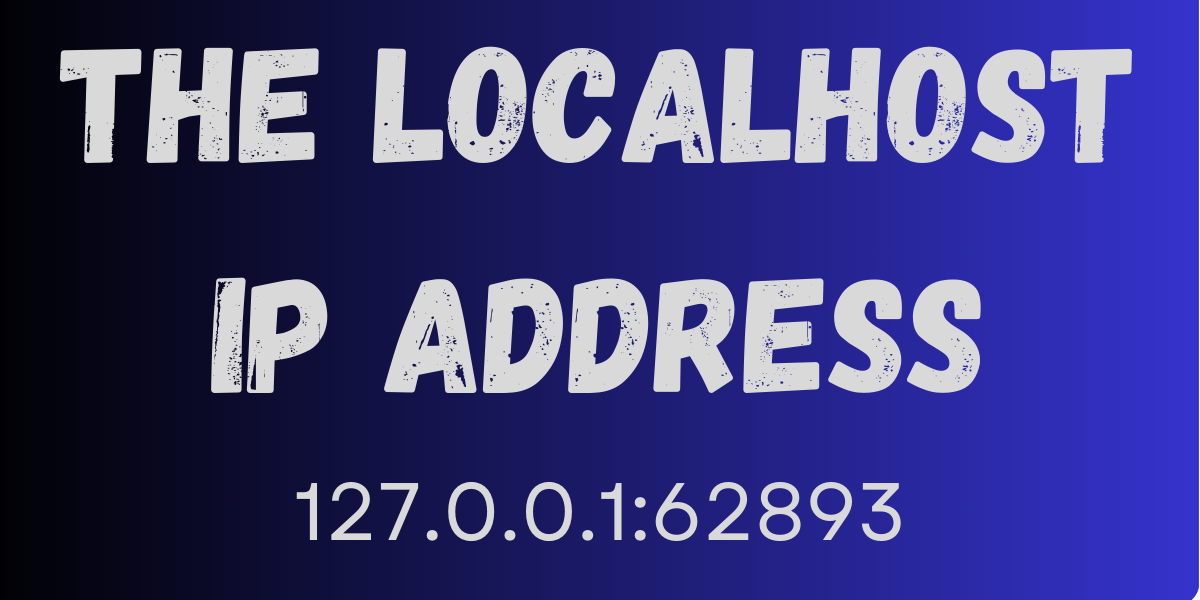
This article will guide you through the basics of localhost IPs, port numbers, and how the address 127.0.0.1:62893 helps developers work efficiently. Along the way, we’ll also discuss essential security practices and troubleshooting tips to ensure smooth local server interactions.
What is Localhost (127.0.0.1)?
At its core, localhost refers to your own computer, acting as a network device to test services locally. Think of it as the machine talking to itself. The IP address 127.0.0.1 is commonly used to represent localhost within a network.
Every operating system reserves this address to allow applications to communicate internally, eliminating the need to send data externally to the internet. When you open a browser and type 127.0.0.1, you are requesting services directly from your computer’s local server.
What Does Port 62893 Mean?
A port in computing acts like a virtual gateway where data packets enter and exit the machine. Port 62893 is one of the many dynamically assigned ports used for communication between different software components. This specific port can vary depending on the local server configurations.
- Common Uses of Ports:
- Web servers use port 80 for HTTP requests.
- Secure websites rely on port 443 for HTTPS.
- Port numbers above 1024, like 62893, are often allocated for temporary services during development.
In practice, 127.0.0.1:62893 directs requests to the local machine on port 62893, often for running applications like Node.js servers, Python Flask APIs, or testing tools.
Why Developers Use 127.0.0.1:62893
Developers use 127.0.0.1 with different port numbers to ensure their programs are running correctly before deployment. Here are some key reasons:
1. Testing in a Safe Environment
Running software locally helps developers test without the risk of exposing unfinished projects to the internet. Port 62893 may be used temporarily by applications to avoid interference with default ports like 80 or 443.
2. Running Multiple Projects Simultaneously
Different ports allow multiple services to operate independently on the same machine. For example:
- 127.0.0.1:62893 might be used for an API project.
- 127.0.0.1:3000 could serve a React application.
3. Avoiding Internet-Dependent Testing
Testing locally ensures that developers don’t need an internet connection to check if their code works. This saves time and reduces distractions during the coding process.
How to Use 127.0.0.1:62893 Effectively
Using 127.0.0.1 with custom ports requires some setup and understanding of your development tools. Here’s how to maximize its benefits:
1. Configuring Local Servers
Many developers use software frameworks like XAMPP, WAMP, Node.js, or Django to run local servers. During configuration, they can assign ports to these servers.
- Example for Node.js:
bash
node server.js --port 62893
2. Accessing the Service via Browser
Once a local service is running, you can visit 127.0.0.1:62893 in your web browser to view the application.
- If everything is correctly configured, you’ll see your web project or API in action.
- If not, you may encounter errors such as “Connection Refused” or “Server Not Found.”
Troubleshooting 127.0.0.1:62893 Issues

Despite its convenience, using localhost ports can lead to technical challenges. Here are common issues and solutions:
1. Port Conflict Issues
Sometimes, two programs try to use the same port, causing a port conflict. To resolve this:
- Stop any service currently using the port with commands like:
bash
lsof -i :62893
kill -9 <PID>
- Use a different port if necessary.
2. Firewall Blocking the Port
Firewalls can block certain ports, preventing access to 127.0.0.1:62893. To fix this:
- Add an exception for the port in your firewall settings.
- Temporarily disable the firewall (not recommended for production).
3. Localhost Not Resolving
If 127.0.0.1 isn’t working, try these steps:
- Clear your browser cache.
- Flush the DNS using this command:
bash
sudo dscacheutil -flushcache
- Check if your hosts file contains the correct entry:
127.0.0.1 localhost
Security Considerations When Using 127.0.0.1 Ports
While localhost testing is secure by default, it’s still important to follow good practices to avoid vulnerabilities:
1. Limit Local Access
Ensure that services running on 127.0.0.1:62893 are restricted to local access only. Avoid exposing these ports to external networks.
2. Use Authentication for Sensitive Tools
If you’re testing admin tools locally, enable password protection or API keys to prevent unauthorized access, even on local networks.
3. Close Unused Ports
After finishing your development work, close any open ports to avoid security risks. Use:
sudo ufw deny 62893
Real-World Applications of 127.0.0.1:62893
Here are a few scenarios where developers might use this localhost address with custom ports:
1. API Development and Testing
A backend developer might run a RESTful API on 127.0.0.1:62893 to verify that all endpoints respond correctly before deployment.
2. Frontend-Backend Integration Testing
During integration, a frontend team might test if their React or Angular application connects properly with the backend running on 127.0.0.1:62893.
3. Database Connections
Local databases, such as MongoDB or MySQL, can also be tested using temporary ports to simulate real-world queries.
For More Information Visit: Peace Magazines
Conclusion
The address 127.0.0.1:62893 plays a crucial role in local development and testing environments. It leverages the loopback functionality of localhost to enable developers, IT professionals, and system administrators to run applications, web servers, and databases safely on their own machines. Using high-numbered ports like 62893 ensures minimal conflicts with well-known services and creates a controlled, isolated environment for testing.
Throughout this article, we’ve explored how localhost and port numbers work together, the history of loopback addresses, and practical use cases. Whether you’re running a local server, troubleshooting networking issues, or setting up a secure development environment, understanding 127.0.0.1:62893 equips you with the tools to be more effective in your work.
From developers creating dynamic websites to IT administrators configuring secure systems, localhost remains indispensable. However, it’s important to ensure that your local applications are correctly configured to avoid port conflicts, security vulnerabilities, or firewall issues. With a strong grasp of how localhost functions, you can confidently run and test applications, ensuring smooth deployment to production environments.
In the ever-evolving world of networking, mastering concepts like 127.0.0.1:62893 lays the foundation for better understanding of more complex networking topics. By leveraging this knowledge, developers and professionals alike can enhance their productivity, streamline testing processes, and build applications with confidence—without worrying about interfering with external networks.
So the next time you see a URL like 127.0.0.1:62893 in your browser or console, you’ll know exactly what’s happening behind the scenes. It’s not just an address—it’s a gateway to efficient local development and troubleshooting.
FAQs
1. What does 127.0.0.1:62893 mean?
127.0.0.1:62893 refers to a combination of a loopback IP address (127.0.0.1) and a port number (62893). The 127.0.0.1 IP address, also known as localhost, points to the local machine you are using, allowing communication between software components running on the same computer. The 62893 is a port number that identifies a specific service or application listening for incoming data on that address. This address/port combination is typically used in development environments to test applications or services locally.
2. Why is 127.0.0.1 used instead of other IP addresses?
The IP address 127.0.0.1 is part of a reserved range for loopback addresses (127.0.0.0/8) and is used specifically for internal communication within a device. It ensures that traffic does not leave the machine or enter the external network. Using 127.0.0.1 allows developers to simulate network environments without needing an active internet connection. Other IP addresses (such as private ones like 192.168.x.x) are meant for communication across a local network, not internally on a single machine.
3. What is the significance of the port number 62893?
Port 62893 is a high-numbered, ephemeral port, meaning it is usually assigned for temporary or user-defined purposes. It is not reserved for any specific service, which makes it a good choice for developers to avoid conflicts with common ports like 80 (HTTP) or 443 (HTTPS). In local development, using high-numbered ports ensures that the services remain isolated and accessible only within the local machine.
4. How do I access 127.0.0.1:62893?
To access an application or service running on 127.0.0.1:62893, follow these steps:
- Ensure the service or web server is correctly configured to listen on port 62893.
- Start the server or application.
- Open your web browser and enter
http://127.0.0.1:62893. If the server is running properly, you’ll see the application’s interface or a relevant response from the service. If you encounter an error, you may need to check firewall settings, ensure no other service is using the port, or confirm that the server is configured correctly.
5. What can cause connection errors with 127.0.0.1:62893?
There are several reasons you might experience issues connecting to 127.0.0.1:62893:
- Port Conflicts: Another application may already be using port 62893.
- Firewall Settings: A firewall might be blocking traffic on that port.
- Server Not Running: The application or service may not be correctly started.
- Syntax Errors: Configuration files or scripts might contain syntax issues.
- Network Adapters: Misconfigured network adapters can cause loopback communication to fail. To troubleshoot, ensure the application is running, try a different port, or adjust your firewall rules to allow local traffic on the specified port.
6. Can I use any other port besides 62893?
Yes, you can use any port number between 1024 and 65535 for non-system applications. Ports below 1024 are reserved for well-known services (like HTTP or FTP), so it’s best to use high-numbered ports, such as 3000, 8080, or 62893, for custom applications. However, ensure that the chosen port is not in use by another service to avoid conflicts.
7. Is 127.0.0.1 accessible from other devices on the network?
No, 127.0.0.1 is not accessible from other devices. It is a loopback address used only within the local machine. If you need other devices to access a service on your machine, you’ll need to use the computer’s private or public IP address instead (e.g., 192.168.x.x). Additionally, you’ll have to ensure the firewall allows traffic on the relevant port and that the application is configured to accept external requests.
8. What is the difference between 127.0.0.1:62893 and localhost:62893?
There is no functional difference between using 127.0.0.1:62893 and localhost:62893. Both refer to the same address, and they both route traffic back to the local machine. However, localhost is a domain name that resolves to 127.0.0.1. In some cases, applications may behave differently due to DNS configurations or software preferences, but both options generally work the same.
9. How do I check if port 62893 is open and being used?
To verify whether port 62893 is open and in use, you can follow these steps:
On Windows:
- Open Command Prompt.
- Run the following command:
css
netstat -a -n | findstr 62893
- If the port is in use, the command will display a line showing the address, port, and state (e.g., LISTENING or ESTABLISHED).
On macOS/Linux:
- Open Terminal.
- Run the following command:
css
lsof -i :62893
- If the port is active, you’ll see details about the process using it.
If no output is shown, the port is free to use.
10. What are some real-world use cases for 127.0.0.1:62893?
The address 127.0.0.1:62893 has several practical uses, particularly in the fields of web development and software testing:
- Local Web Development: Developers often run their websites on localhost before deploying them to production. Using ports like 62893 allows for multiple web applications to run simultaneously without conflict.
- Database Testing: Many database services (e.g., MySQL, PostgreSQL) can be configured to listen on localhost for testing purposes. Developers may assign custom ports like 62893 for temporary projects.
- API Development: APIs are frequently tested on localhost to ensure they work as intended. Developers can quickly check endpoints without the need for public hosting.
- Software Debugging: System administrators and developers use localhost to identify bugs in their applications. Running a server on a high port like 62893 makes it easy to isolate processes.
- Virtual Machines and Containers: In environments like Docker or virtual machines, localhost is used to communicate between containers and the host machine. Assigning high-numbered ports like 62893 ensures smooth communication without interference.







